564-94-3
| 中文名 | 桃金娘烯醛 |
|---|---|
| 英文名 | Myrtenal |
| 中文别名 | 6,6-二甲基二环[3.1.1]庚-2-烯-2-甲醛 |
| 英文别名 |
(1R,5S)-6,6-dimethyl-bicyclo[3.3.1]hept-2-en-2-carbaldehyde
pin-2-ene-1-carbaldehyde 2-Norpinene-2-carboxaldehyde,6,6-dimethyl EINECS 209-274-8 (1R)-(-)-MYRTENAL 6,6-dimethyl-2-norpinene-2-carboxaldehyd Pin-2-en-1-carbaldehyd MFCD00074768 Pina-2-ene-10-al (-)-1R-6,6-dimethylbicyclo[3.1.1]hept-2-ene-2-carboxaldehyde (R)-mirtenal Benihinal (R)-6,6-dimethylbicyclo[3.3.1]hept-2-en-2-carboxaldehyde 2-Formyl-6,6-dimethylbicyclo(3.1.1)hept-2-ene |
| 描述 | Myrtenal ((±)-Myrtenal) 是一种单萜,可作为抗肿瘤剂。Myrtenal 可通过阻止 DEN-PB 诱导的 TNF-α 蛋白表达上调来抑制肝癌。 |
|---|---|
| 相关类别 | |
| 参考文献 |
| 密度 | 1.061g/cm3 |
|---|---|
| 沸点 | 215.7ºC at 760mmHg |
| 分子式 | C10H14O |
| 分子量 | 150.22 |
| 闪点 | 78.9ºC |
| 精确质量 | 150.10400 |
| PSA | 17.07000 |
| LogP | 2.17770 |
| 折射率 | n20/D 1.504 |
| 储存条件 | 室温 |
| 分子结构 | 五、分子性质数据: 1、 摩尔折射率:45.86 2、 摩尔体积(m3/mol):141.4 3、 等张比容(90.2K):356.4 4、 表面张力(dyne/cm):40.2 5、 极化率(10-24cm3):18.18 |
| 计算化学 | 1.疏水参数计算参考值(XlogP):2.1 2.氢键供体数量:0 3.氢键受体数量:1 4.可旋转化学键数量:1 5.互变异构体数量:无 6.拓扑分子极性表面积17.1 7.重原子数量:11 8.表面电荷:0 9.复杂度:225 10.同位素原子数量:0 11.确定原子立构中心数量:0 12.不确定原子立构中心数量:2 13.确定化学键立构中心数量:0 14.不确定化学键立构中心数量:0 15.共价键单元数量:1 |
| 更多 | 一、物性数据 1. 沸点:220-221°C。 |
Synonym:Benihinal; 6,6-Dimethylbicyclo(3.1.1)hept-2-ene-2-carboxaldehyde; 2-Formyl-6,6-dimethylbicyclo(3.1.1)hept-2-ene; Myrtenal; 2-Norpinene-2-carboxaldehyde, 6,6-dimethyl-; Bicyclo(3.1.1)hept-2-ene-2-carboxaldehyde, 6,6-dimethyl- Section 2 - COMPOSITION, INFORMATION ON INGREDIENTS
Risk Phrases: None Listed. Section 3 - HAZARDS IDENTIFICATION EMERGENCY OVERVIEW
Not available. Potential Health Effects Eye: May cause eye irritation. Skin: May cause skin irritation. Ingestion: May cause gastrointestinal irritation with nausea, vomiting and diarrhea. Inhalation: May cause respiratory tract irritation. Chronic: Effects may be delayed. Section 4 - FIRST AID MEASURES Eyes: Immediately flush eyes with plenty of water for at least 15 minutes, occasionally lifting the upper and lower eyelids. Get medical aid. Skin: Get medical aid. Flush skin with plenty of water for at least 15 minutes while removing contaminated clothing and shoes. Wash clothing before reuse. Ingestion: Never give anything by mouth to an unconscious person. Get medical aid. Do NOT induce vomiting. If conscious and alert, rinse mouth and drink 2-4 cupfuls of milk or water. Inhalation: Remove from exposure and move to fresh air immediately. If not breathing, give artificial respiration. If breathing is difficult, give oxygen. Get medical aid. Notes to Physician: Treat symptomatically and supportively. Section 5 - FIRE FIGHTING MEASURES General Information: As in any fire, wear a self-contained breathing apparatus in pressure-demand, MSHA/NIOSH (approved or equivalent), and full protective gear. During a fire, irritating and highly toxic gases may be generated by thermal decomposition or combustion. Use water spray to keep fire-exposed containers cool. Vapors may be heavier than air. They can spread along the ground and collect in low or confined areas. Containers may explode when heated. Combustible liquid and vapor. Extinguishing Media: Use water spray to cool fire-exposed containers. Water may be ineffective. Use water spray, dry chemical, carbon dioxide, or appropriate foam. Section 6 - ACCIDENTAL RELEASE MEASURES General Information: Use proper personal protective equipment as indicated in Section 8. Spills/Leaks: Clean up spills immediately, observing precautions in the Protective Equipment section. Cover with sand, dry lime or soda ash and place in a closed container for disposal. Remove all sources of ignition. Provide ventilation. Section 7 - HANDLING and STORAGE Handling: Wash thoroughly after handling. Remove contaminated clothing and wash before reuse. Use only in a well-ventilated area. Avoid contact with eyes, skin, and clothing. Keep container tightly closed. Avoid ingestion and inhalation. Keep away from heat and flame. Storage: Keep away from sources of ignition. Store in a tightly closed container. Store in a cool, dry, well-ventilated area away from incompatible substances. Section 8 - EXPOSURE CONTROLS, PERSONAL PROTECTION Engineering Controls: Facilities storing or utilizing this material should be equipped with an eyewash facility and a safety shower. Use adequate general or local explosion-proof ventilation to keep airborne levels to acceptable levels. Exposure Limits CAS# 564-94-3: Personal Protective Equipment Eyes: Wear appropriate protective eyeglasses or chemical safety goggles as described by OSHA's eye and face protection regulations in 29 CFR 1910.133 or European Standard EN166. Skin: Wear appropriate protective gloves to prevent skin exposure. Clothing: Wear appropriate protective clothing to prevent skin exposure. Respirators: A respiratory protection program that meets OSHA's 29 CFR 1910.134 and ANSI Z88.2 requirements or European Standard EN 149 must be followed whenever workplace conditions warrant respirator use. Section 9 - PHYSICAL AND CHEMICAL PROPERTIES Physical State: Liquid Color: clear very slight yellow Odor: None reported. pH: Not available. Vapor Pressure: Not available. Viscosity: Not available. Boiling Point: 220 - 221 deg C Freezing/Melting Point: Not available. Autoignition Temperature: Not applicable. Flash Point: 78 deg C ( 172.40 deg F) Explosion Limits, lower: Not available. Explosion Limits, upper: Not available. Decomposition Temperature: Not available. Solubility in water: Not available. Specific Gravity/Density: .9800 g/cm3 Molecular Formula: C10H14O Molecular Weight: 150.22 Section 10 - STABILITY AND REACTIVITY Chemical Stability: Stable at room temperature in closed containers under normal storage and handling conditions. Conditions to Avoid: Ignition sources, excess heat. Incompatibilities with Other Materials: Strong oxidizing agents, strong bases. Hazardous Decomposition Products: Carbon monoxide, carbon dioxide. Hazardous Polymerization: Has not been reported. Section 11 - TOXICOLOGICAL INFORMATION RTECS#: CAS# 564-94-3: DT5180000 LD50/LC50: CAS# 564-94-3: Oral, rat: LD50 = 2300 mg/kg; Skin, rabbit: LD50 = >5 gm/kg. Carcinogenicity: (-)-Myrtenal - Not listed by ACGIH, IARC, or NTP. Other: See actual entry in RTECS for complete information. Section 12 - ECOLOGICAL INFORMATION Section 13 - DISPOSAL CONSIDERATIONS Dispose of in a manner consistent with federal, state, and local regulations. Section 14 - TRANSPORT INFORMATION IATA Not regulated as a hazardous material. IMO Not regulated as a hazardous material. RID/ADR Not regulated as a hazardous material. Section 15 - REGULATORY INFORMATION European/International Regulations European Labeling in Accordance with EC Directives Hazard Symbols: Not available. Risk Phrases: Safety Phrases: S 24/25 Avoid contact with skin and eyes. WGK (Water Danger/Protection) CAS# 564-94-3: No information available. Canada CAS# 564-94-3 is listed on Canada's DSL List. CAS# 564-94-3 is not listed on Canada's Ingredient Disclosure List. US FEDERAL TSCA CAS# 564-94-3 is listed on the TSCA inventory. SECTION 16 - ADDITIONAL INFORMATION N/A |
CHEMICAL IDENTIFICATION
HEALTH HAZARD DATAACUTE TOXICITY DATA
|
| 安全声明 (欧洲) | S23-S24/25 |
|---|---|
| WGK德国 | 2 |
| RTECS号 | DT5180000 |
| 上游产品 6 | |
|---|---|
| 下游产品 7 | |


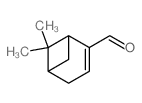
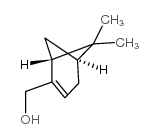

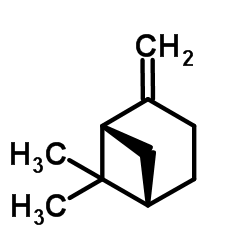
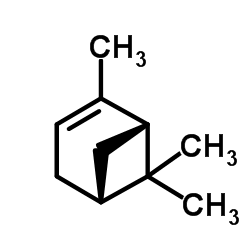
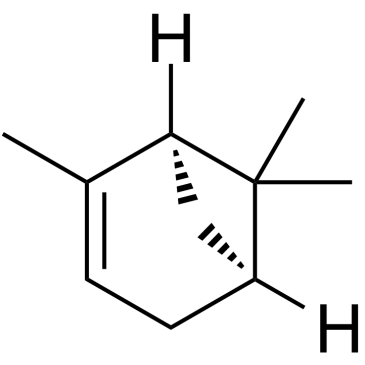


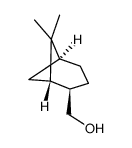

![7,7-dimethylbicyclo[3.1.1]hept-3-ene结构式](https://image.chemsrc.com/caspic/274/32863-61-9.png)
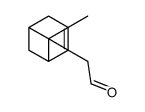
![Bicyclo[3.1.1]hept-2-ene,2-ethenyl-6,6- dimethyl-结构式](https://image.chemsrc.com/caspic/299/473-00-7.png)